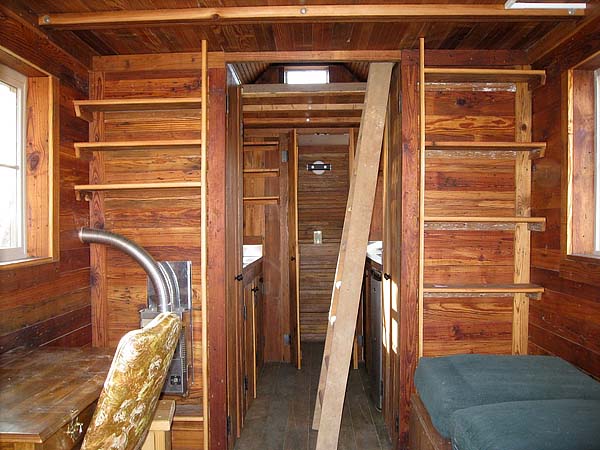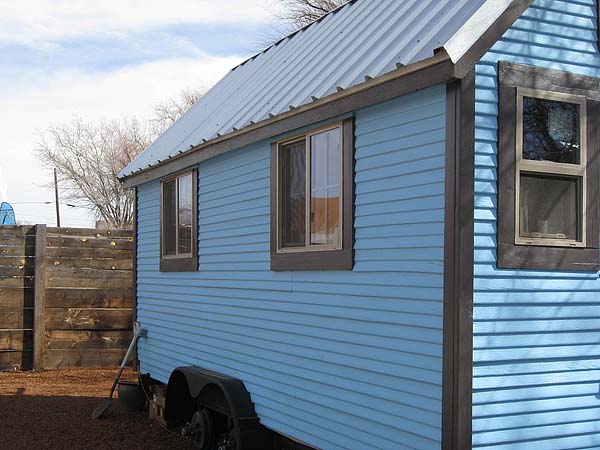Pat Crowe of Echo Reclamation recently sent some photos of a modified Tumbleweed Lusby he completed using reclaimed materials. He wanted to let me know that he is offering the materials for sale to tiny home builders interested in completing their homes in this way.
Pat is located in Albuquerque, New Mexico. The client who contracted the Lusby contraction wanted all reclaimed wood, so the interior ceiling, loft floors, walls, doors, cabinets, closets and shelves are all made of antique pine (pre-1930) that Pat brought from Texas, his home state. The exterior is of pine siding salvaged in Texas from a c. 1915 house that was slated for demolition. This is southern pine, much of it longleaf, and is beautiful material.

Pat says that using this type of material is more expensive to purchase and requires more labor to use, so it’s not a money-saving deal. But, if someone is looking for character and the satisfaction of participating in the salvage of wonderful old wood, it’s worth the extra cost.
I think that this is a nice option to have and you can contact Pat Crowe at Echo Reclamation at 505-918-5000. Also to view more pictures of what he has to offer please visit his website http://www.echoreclamation.com/reclaimed-wood/

[nggallery id=40]
This is EXACTLY what I want to do. It looks great, and it has a lovely feel.
I do agree with some points made in the posting, but some points were left out. It is true that using salvaged materials takes more labor, sometimes a lot more labor. It is also true that it can sometimes (and I stess “sometimes”) be expensive to buy, especially if you are buying materials that someone else has reconditioned. I am not saying that this is unfair. Far from it. If some else has gone through the trouble of finding, pulling out and reconditioning the wood that you are using, they deserve to be compensated for their time. But using salvaged material can also be dirt cheap. I have renovated three houses to date, the last two largely with salvaged materials and the cost has been far. far below the price of new materials. It depends on where you shop. I use building reuse stores, the type of store that sells old fixtures, wood, windows, doors, tile, carpet ect that have been either pulled out by builders and turned in for free or are the result of incorrect orders from manufacturers. You have to do any reconditioning yourself, but it’s worth it. The wood is especially cheap. I also use craigslist which is a gold mine. In contrast, my city has another reuse store that takes up several warehouses downtown. The stuff can be jaw dropping beautiful. Think 10 X 12 feet stained glass skylight from an old hotel or cast iron ticket window screens from old train stations. This stuff has been reconditioned before you buy it and you pay top dollar for the service. So is using salvaged material more work? Almost always. Is it more expensive? It depends on where you shop and if someone has done some of the reconditioning before you buy it. So, don’t rule salvage out just on expense alone. Good luck out there and happy hunting.
Makes me think about all the “abandoned” buildings I see, and photograph, out in the country… lots of material out there going to waste. Although would you please let me get a photo of it first before you tear it down 🙂
Building with old wood is also a positive in that it is very stable, won’t twist bend warp like new material. Also the older boards were larger sizes and thicker than what you can get now. Think of the old wide pine floor planks, you just can’t get those now a days.
As Ava says if you do the work you can save a lot of money by using your time, in the end it depends on what your time is worth.
Lots of people would let you take down an old building if you hall it away. What a lot of people don’t realize is that these old boards are just a sanding away from looking great.
The wood is beautifil and well worth the extra labor. Think of the resale value too!
Walt
My granddaughter’s 93 year old school is undergoing major renovations and somewhere along the way all the old black walnut trim and mouldings have been replaced with that cheap pressed sawdust junk. Nobody seems to know where the original stuff went, sure hope it didn’t end up trashed.
Ah! Just hearing about all this old stuff makes me smile! I will echo that it usually costs a little more, when all is said and done, to use reclaimed materials. HOWEVER, if I am flexible about what i will find, and where i use it – it almost always can come out great (cost and time wise). Usually, like the old pine siding, the disappeared walnut trim… the 1940’s red-brass porch lights i just found (for $10/pr and 2 hrs rewiring).
Of course, i have a shop (crowded, yes) in which i can place the materials until their day and project comes around. Time is on your side, if you are patient, and it is sometimes worth just the story that these older things carry. Wow!
Great Posting. The real issue is whether you have time or money, or whether you really enjoy making something beautiful from something someone else threw away. Also what does your home say about you? When you put this kind of effort into something, it says alot.
I love old pine, its the most beautiful of all woods to me. I once built a log home, and used nothing but old pine throughout the whole house, reclaimed from an old sharecroppers house that was being demolished and a factory that was getting torn down. Some of the wood had musket balls imbedded into it.
I love the interior of this tiny home, but have to wonder what it was about that blue that made it look like it belonged on the outside. /-:
Very beautiful work! I am a huge fan of reuse/recycling materials.
But as a builder I just would like to remind everyone that allot of old wood has lead paint on it as well as hidden fasteners. There are very strict RRP regulations regarding lead containment that are in effect now. You should use a respirator and HEPA filter on your vacuum to contain the dust and wear glasses to protect your eyes from hidden fasteners when you cut or plane the wood.
Be safe! And happy trails!
Good advice! Old paint can be blown into every corner of your shop or lungs when planing or sanding… Sometimes its better to refuse that old painted stuff.
A trick we used to do when remilling large quantities of old flooring or barn wood was to use a metal detector to find all the hidden fasteners! Worked perfectly.
Beautiful!
Beautiful work. I don’t care, at all, for the exterior colors; however, the wood work, on the interior is awesome. Reclaimed lumber can really make a wall with a story.
The best way to acquire used lumber is to find some old houses and offer to demolish then for the lumber and other materials. I built 80% of my first house that way. I have a group of buddies that helped me out – we rotate helping each other with projects. In 5 weekends, we disassembled 3 houses: one of them was over 5,000 square ft. We rented a lift, front end loader, with fork attachments and some chainsaws. When we finished sorting and cleaning all the material, I had a 60’X30′ warehouse full, estimated value of $60K. I purchased a planer and radial arm saw and worked for 4 months, making the lumber look new and cut to specific dimensions. Of course, there was some of the lumber that was left with the aged look.
There’s lots of old bldgs/houses out there needing to be demolished. In some of the bigger cities, you can find a bunch, owned by the city and they will let you demolish them. You may have to purchase a temporary insurance policy; but, it’s worth is, if you get the right bldgs. Look for house/bldgs with good roofs or close to good, so that the materials will be dry.
Nice little house, very warm and cozy – a really great job using salvaged lumber. I do strongly feel a good washdown with Murphy’s Oil Soap and sealing with linseed oil, or something similar. would do wonders to buff it up a little bit and renew the wood’s look. The home deserves to shine as best it can!